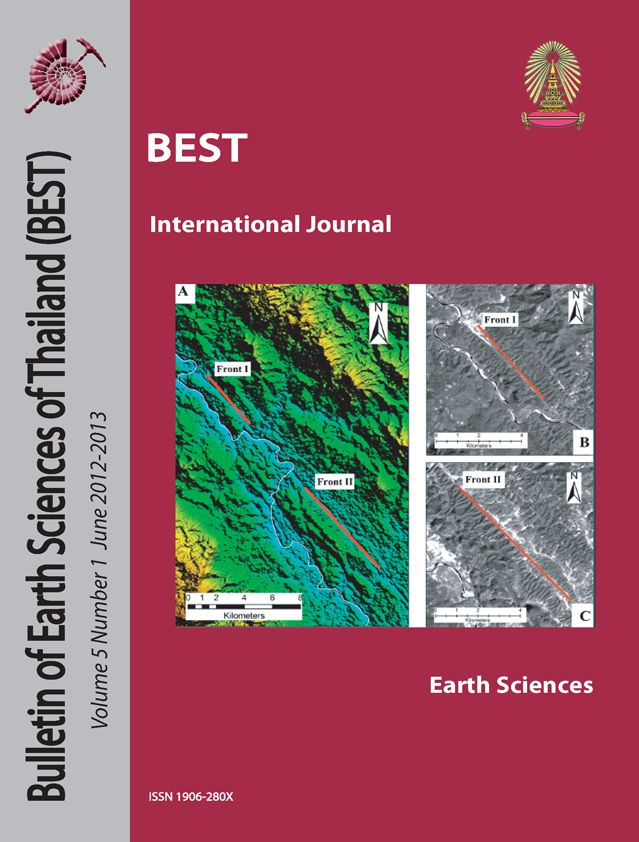Application of Airborne Geophysics to the Interpretation of Geologic Setting in Nan-Uttaradit Area, Northern Thailand
Main Article Content
Abstract
This investigation is aimed to process airborne magnetic and radiometric data by various techniques. We applied RTP, vertical derivative for airborne magnetic data and Cooking Technique for airborne radiometric data. Three magnetic domains have been identified, namely northern, central and southern domain. The central domain is a significant highly anomalous NESW trending narrow zone, possesses high magnetic and low radiometric intensities. This central high is enveloped by very low magnetic and high radiometric intensities. Both of the north and south domains, which roughly orient in the N-S trend, exhibit low magnetic and various radiometric intensities with the sporadic high magnetic patterns. The high magnetic anomalies in this area has been recognized in 2 patterns, elongate pattern located in central high and circular pattern located in the northernmost area. The polarity of magnetic bodies was identified by magnetic modeling program and shows the well-defined east-dipping direction. It can be summarized that the Nan suture shows eastward-dipping anomaly indicating the eastward polarity of the plate, by the collision tectonic setting. Therefore, it is ascertained that the Nan suture zone can be well delineated from this study.
Article Details

This work is licensed under a Creative Commons Attribution-NonCommercial-NoDerivatives 4.0 International License.
Copyright © 2008 Department of Geology, Faculty of Science, Chulalongkorn University. Parts of an article can be photocopied or reproduced without prior written permission from the author(s), but due acknowledgments should be stated or cited accordingly.
References
Barr, S.M., and MacDonald, A.S., 1987, Nan river suture zone, northern Thailand; Geology, v. 15, p. 907-910
Bunopas, S., and Vella, P., 1983, Tectonic and geologic evolution of Thailand; Proceedings on Stratigraphic Correlation of Thailand and Malaysia, Haad Yai, Thailand, p. 307-317.
Hinthong, C., Raksaskulwong, L., and Khositanont, S., 1999, A reconstruction of geology of the Nan area and its vicinities, Northern Thailand; Proceedings of the Symposium on Mineral, Energy, and Water Resources of Thailand: Toward the Year 2000, Bangkok, Thailand, p. 178-196.
Kiatiwongchai, T., 1995, Airborne geophysical data interpretation of the Uttaradit-Nan area: General background and aeromagnetic interpretation; Mineral Resources Development Division Report no. 6/1995, Department of Mineral Resources, Bangkok, 35p.
Kuttikul, P., Boonsanong, A. Paiyarom, A. and Anukul S., 1988, Report on the AEM interpretation in Uttaradit-Nan area; Economic Geology report no. 52/1987, Economic Geology Division, Department of Mineral Resources, 22 p. (in Thai)
Lunwongsa, W., 2004, Chromian spinel from some ultramafic igneous rocks in northern and eastern Thailand, unpublished M.Sc. thesis, Chulalongkorn University, Thailand, 123 p.
Macdonald, A.S., and Barr, S.M., 1984, The Nan river mafic-ultramafic belt, northern Thailand: Geochemistry and tectonic significance, Geological Society of Malaysia Bulletin no. 17, p. 209-224.
Neawsuparp, K., 1997, Image processing of Landsat TM and integration with aeromagnetic data for structural interpretation of the Nan suture zone; Proceedings of a conference on geophysics in prospection for natural resources, engineering and environmental problems, Hat Yai, Thailand, p.139-148.
Neawsuparp, K., 2004, Application of Airborne Geophysical and Remote Sensing Data to Structural Geology and Tectonic Setting in Loei Area, Northeastern Thailand, unpublished Ph.D. thesis, Chulalongkorn University, Thailand, 175 p.
Paiyarom, A. and Surinkum, A, 1997, Report on the ground geophysical follow-up survey in the Uttaradit-Nan AEM survey area, Mineral Resources Development Division Report no. 10/1997, Department of Mineral Resources, Bangkok, 29p. (in Thai).
Panjasawatwong, Y., 1991, Petrology, geochemistry and tectonic implications of igneous rocks in the Nan suture, Thailand and an empirical study of the effects of Ca/Na, Al/Si and H2O on plagioclase-melt equilibria at 5-10 Kb pressure; unpublished Ph.D. thesis, University of Tasmania, Australia, 239 p.
Pintawong, C., 1998, Mineral investigation in Uttaradit-Nan area, Mineral Resources Development Division Report no. 6/1997, Department of Mineral Resources, Bangkok, 57p. (in Thai).
Singharajwarapan, S. 1993. Structural analysis of the Accretionary complex in Sirikit Dam area, Uttaradit, Northern Thailand. Journal of Southeast Asian Earth Sciences 8: 233-245.
Sukontapongpow, S., 1997, Recent airborne geophysical surveys of Thailand and their use for delineation of high mineral potential area; Mineral Resources Development Division Report no. 18/1997, Department of Mineral Resources, Bangkok, 226p.
Surinkum, A., 2006, Evaluation of mineral deposit potential in Nan-Uttaradit Suture Zone using geophysical data, unpublished Ph.D. thesis, Chiang Mai University, Thailand, 228 p.
Thongchit, P., 1997, Airborne interpretation on the Nan-Xaignabouri; Mineral Resources Development Division no. 22/1997, Department of Mineral Resources, Bangkok, 54p. (in Thai).
Tulyatid, J., 1997, Application of airborne geophysical data to the study of Cenozoic basins in Central Thailand; unpublished Ph.D. thesis, Leeds University, United Kingdom, 235p.
Yensabai, S. 2002. Mineral resources potentials map, scale 1:250,000, sheet (Changwat Nan). Economic Geology Division. Department of Mineral Resources.


